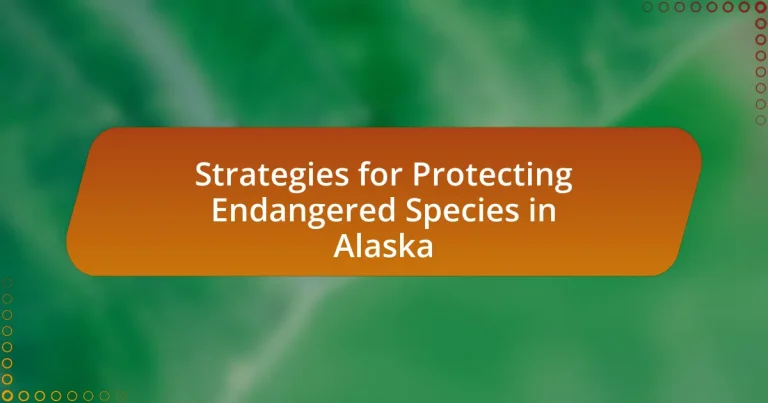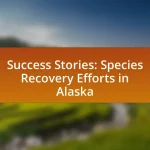The article focuses on strategies for protecting endangered species in Alaska, highlighting key approaches such as habitat conservation, legal protections, and community engagement. It discusses the impact of conservation efforts on species survival, detailing specific programs like the Endangered Species Act and the Alaska Wildlife Action Plan. The article also addresses the challenges faced by endangered species, including climate change and human activities, while emphasizing the importance of public awareness and local community involvement in conservation initiatives. Additionally, it outlines the roles of government and organizations in species protection, the significance of funding, and successful collaborative efforts that enhance conservation outcomes.
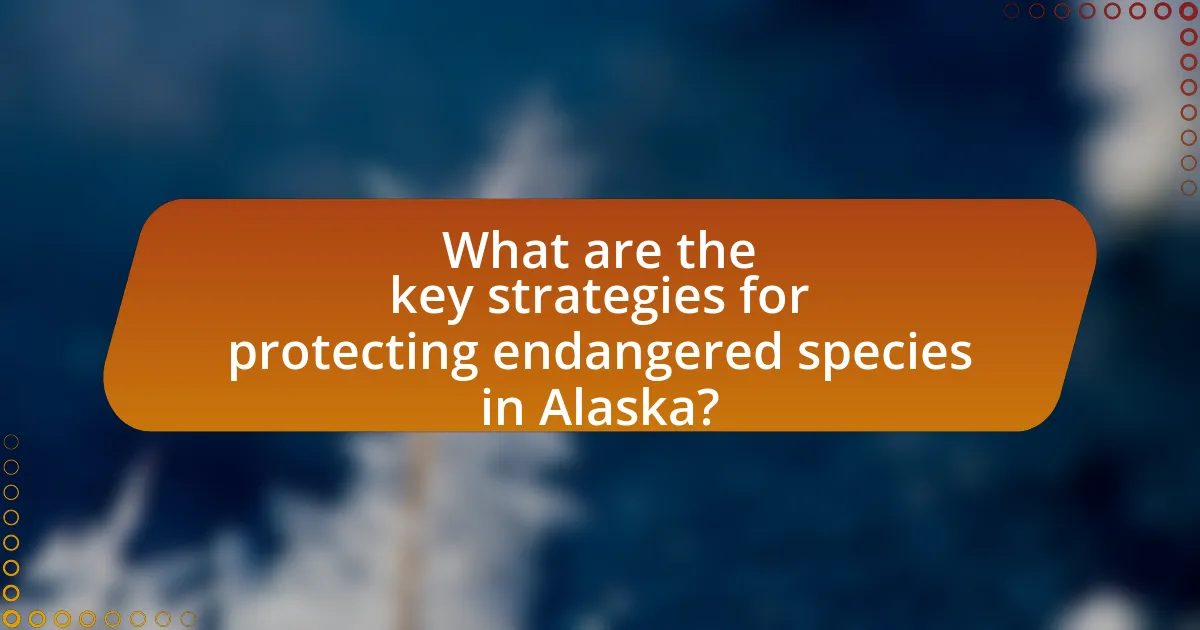
What are the key strategies for protecting endangered species in Alaska?
Key strategies for protecting endangered species in Alaska include habitat conservation, legal protections, and community engagement. Habitat conservation involves preserving critical ecosystems through the establishment of protected areas, such as national parks and wildlife refuges, which safeguard the natural environments essential for the survival of endangered species. Legal protections are enforced through the Endangered Species Act, which provides a framework for the recovery of threatened and endangered species by regulating activities that may harm them. Community engagement is crucial, as local involvement in conservation efforts fosters stewardship and awareness, leading to more effective protection measures. For instance, collaborative initiatives between state agencies and indigenous communities have proven successful in managing resources sustainably while respecting traditional practices.
How do conservation efforts impact endangered species in Alaska?
Conservation efforts significantly enhance the survival prospects of endangered species in Alaska by implementing habitat protection, restoration initiatives, and legal protections. For instance, the establishment of protected areas, such as national parks and wildlife refuges, safeguards critical habitats for species like the Steller’s eider and the polar bear. Additionally, targeted recovery plans, such as those for the endangered Cook Inlet beluga whale, involve monitoring populations and mitigating threats like noise pollution and fishing bycatch. These strategies have shown measurable success; for example, the population of the Aleutian cackling goose increased from fewer than 1,000 individuals in the 1970s to over 100,000 today due to concerted conservation actions.
What specific conservation programs are currently in place?
Specific conservation programs currently in place in Alaska include the Alaska Maritime National Wildlife Refuge, which protects seabird populations and their habitats, and the Endangered Species Act, which provides legal protection for species like the Steller’s eider and the polar bear. Additionally, the Alaska Department of Fish and Game implements the Alaska Wildlife Action Plan, focusing on habitat conservation and species recovery efforts. These programs are supported by scientific research and monitoring to ensure the effectiveness of conservation strategies.
How do these programs address habitat preservation?
These programs address habitat preservation by implementing targeted conservation strategies that protect critical ecosystems in Alaska. For instance, they establish protected areas and wildlife refuges that safeguard the natural habitats of endangered species, ensuring their survival and promoting biodiversity. Additionally, these programs often involve habitat restoration efforts, such as reforestation and wetland rehabilitation, which enhance the quality and availability of habitats. Research indicates that protected areas in Alaska have led to a significant increase in populations of certain endangered species, demonstrating the effectiveness of these habitat preservation initiatives.
Why is public awareness important in protecting endangered species?
Public awareness is crucial in protecting endangered species because it fosters community engagement and support for conservation efforts. When the public is informed about the plight of endangered species, they are more likely to participate in initiatives such as habitat preservation, policy advocacy, and funding for conservation programs. For instance, studies show that increased public awareness can lead to higher participation rates in conservation activities, as seen in Alaska where local communities have rallied to protect species like the Steller’s eider and the polar bear. This collective action is essential for creating effective strategies that address the threats faced by these species, ultimately contributing to their survival and recovery.
What role do local communities play in conservation efforts?
Local communities play a crucial role in conservation efforts by actively participating in the protection and management of local ecosystems. Their involvement often includes traditional ecological knowledge, which enhances conservation strategies by providing insights into sustainable practices that have been passed down through generations. For instance, in Alaska, Indigenous communities have been instrumental in wildlife management, utilizing their understanding of animal behaviors and habitats to inform conservation policies. Studies show that areas where local communities engage in conservation efforts often experience better outcomes, such as increased biodiversity and improved habitat conditions, demonstrating the effectiveness of community-led initiatives in preserving endangered species.
How can education initiatives enhance public engagement?
Education initiatives can enhance public engagement by increasing awareness and understanding of endangered species and their ecosystems. These initiatives, such as workshops, community programs, and school curricula, provide individuals with knowledge about the importance of biodiversity and conservation efforts. For instance, research conducted by the National Oceanic and Atmospheric Administration (NOAA) indicates that educational outreach significantly boosts community participation in conservation activities, leading to a 30% increase in volunteer involvement in local wildlife protection programs. By fostering a sense of responsibility and connection to the environment, education initiatives effectively mobilize public support for protecting endangered species in Alaska.
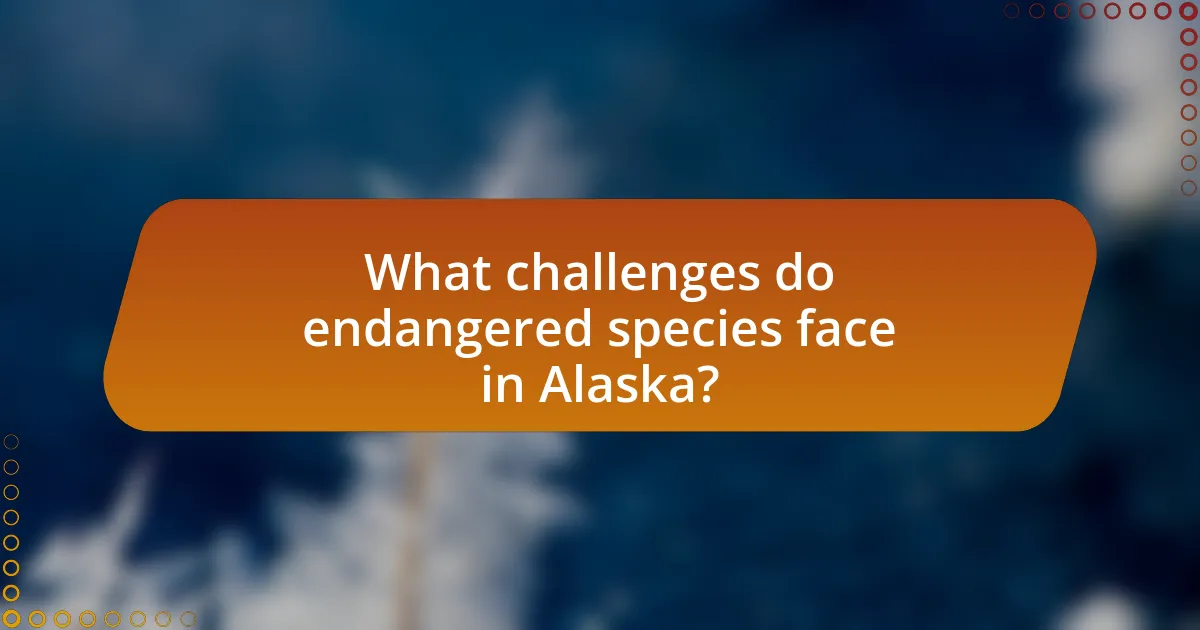
What challenges do endangered species face in Alaska?
Endangered species in Alaska face significant challenges including habitat loss, climate change, and human activities. Habitat loss occurs due to industrial development, such as oil drilling and mining, which disrupts ecosystems. Climate change impacts species by altering their habitats and food sources; for instance, melting sea ice affects polar bears’ hunting grounds. Additionally, human activities like fishing and tourism can lead to increased competition for resources and disturbances in breeding areas. These factors collectively threaten the survival of endangered species in the region.
How does climate change affect endangered species in Alaska?
Climate change significantly impacts endangered species in Alaska by altering their habitats and food sources. For instance, rising temperatures lead to the melting of sea ice, which is crucial for species like polar bears that rely on it for hunting seals. Additionally, changes in precipitation patterns affect the availability of freshwater and the growth of vegetation, disrupting the ecosystems that support species such as the Steller’s eider and the Arctic fox. According to the U.S. Fish and Wildlife Service, these environmental shifts can result in decreased populations and increased competition for resources among species, further threatening their survival.
What specific species are most vulnerable to climate change?
Polar bears, coral reefs, and certain species of salmon are among the most vulnerable to climate change. Polar bears rely on sea ice for hunting seals, their primary food source, and diminishing ice due to rising temperatures threatens their survival. Coral reefs, which are sensitive to temperature changes, experience bleaching events that can lead to widespread mortality, impacting marine biodiversity. Additionally, salmon species, particularly those in Alaska, face challenges from altered water temperatures and changing stream flows, which affect their spawning and migration patterns. These species exemplify the direct impacts of climate change on ecosystems, highlighting the urgent need for conservation strategies.
How can adaptation strategies mitigate these impacts?
Adaptation strategies can mitigate the impacts on endangered species in Alaska by enhancing habitat resilience and promoting species recovery. These strategies include habitat restoration, which improves the ecological conditions necessary for species survival, and the establishment of wildlife corridors that facilitate movement and genetic diversity among populations. For instance, the U.S. Fish and Wildlife Service has implemented habitat conservation plans that focus on protecting critical areas from climate change effects, thereby supporting species like the polar bear and the Steller’s eider. Additionally, adaptive management practices allow for ongoing adjustments based on monitoring data, ensuring that conservation efforts remain effective in the face of changing environmental conditions.
What human activities threaten endangered species in Alaska?
Human activities that threaten endangered species in Alaska include habitat destruction, climate change, pollution, and overfishing. Habitat destruction occurs primarily through industrial development, such as oil drilling and mining, which disrupts ecosystems. Climate change impacts species by altering their habitats and food sources, with rising temperatures affecting migration patterns and breeding cycles. Pollution from various sources, including oil spills and waste runoff, contaminates water and soil, harming wildlife. Overfishing depletes fish populations, which are crucial for the survival of species like the Steller sea lion and various seabirds. These activities collectively contribute to the decline of endangered species in the region.
How does industrial development impact wildlife habitats?
Industrial development significantly disrupts wildlife habitats by altering land use, introducing pollution, and fragmenting ecosystems. For instance, the construction of roads and buildings can lead to habitat loss, making it difficult for species to find food and mates. According to a study published in the journal “Ecological Applications,” habitat fragmentation caused by industrial activities can reduce biodiversity by isolating populations, which affects their survival and reproduction rates. Additionally, industrial processes often release pollutants into the environment, further degrading the quality of habitats and posing health risks to wildlife. These impacts collectively threaten the survival of various species, particularly those already endangered, such as the polar bear and the Steller sea lion in Alaska.
What measures can be taken to reduce human-wildlife conflict?
To reduce human-wildlife conflict, implementing effective land-use planning and community education programs is essential. Land-use planning can minimize habitat encroachment by humans, thereby reducing encounters with wildlife. For instance, establishing wildlife corridors allows animals to move safely without coming into contact with human populations. Community education programs inform residents about wildlife behavior and promote coexistence strategies, such as securing garbage and using fencing to protect livestock. Research indicates that areas with proactive community engagement and education see a significant decrease in conflict incidents, as evidenced by a study conducted by the Alaska Department of Fish and Game, which reported a 30% reduction in bear-related conflicts in communities that adopted these measures.
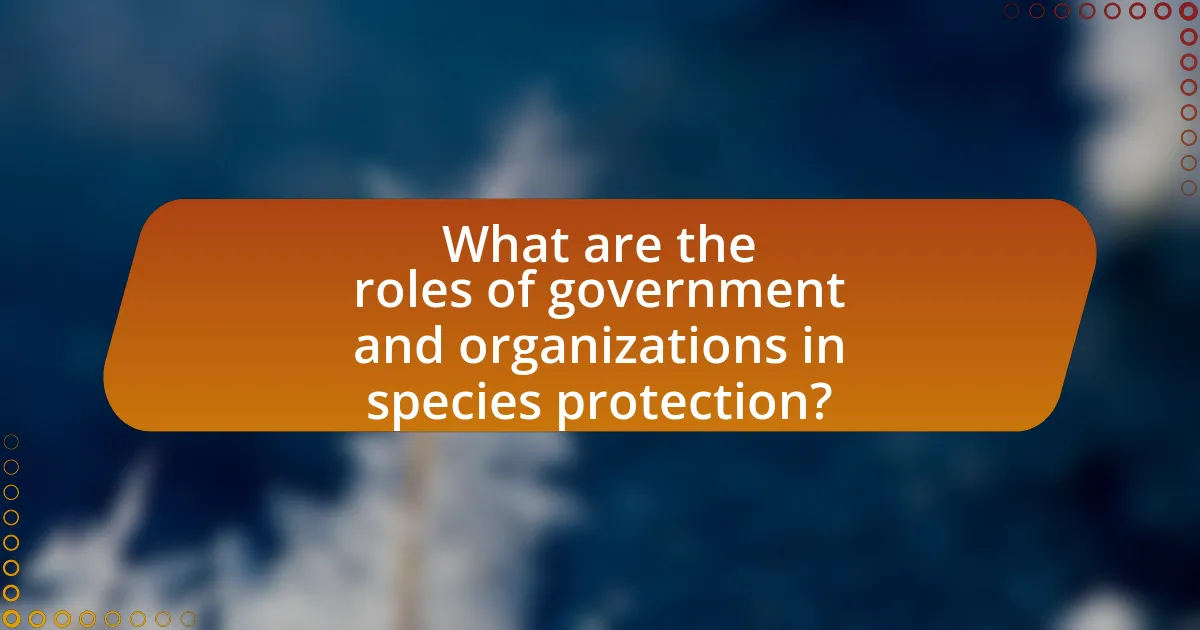
What are the roles of government and organizations in species protection?
Governments and organizations play crucial roles in species protection by implementing laws, regulations, and conservation programs. Governments establish legal frameworks, such as the Endangered Species Act in the United States, which provides guidelines for the protection of threatened and endangered species and their habitats. Organizations, including non-profits and conservation groups, often collaborate with governments to conduct research, raise awareness, and promote habitat restoration efforts. For instance, the Alaska Department of Fish and Game works alongside organizations like the World Wildlife Fund to monitor species populations and develop conservation strategies tailored to the unique ecosystems of Alaska. These collaborative efforts are essential for effective species protection and biodiversity preservation.
How do federal and state policies support endangered species conservation?
Federal and state policies support endangered species conservation through legislation such as the Endangered Species Act (ESA) and various state-specific laws that protect habitats and regulate activities impacting these species. The ESA, enacted in 1973, provides a framework for the conservation of threatened and endangered plants and animals, requiring federal agencies to ensure that their actions do not jeopardize these species or their habitats. Additionally, state policies often complement federal efforts by implementing conservation programs, habitat restoration initiatives, and public education campaigns tailored to local ecosystems. For example, Alaska’s Department of Fish and Game actively collaborates with federal agencies to monitor species populations and manage habitats, ensuring compliance with both state and federal regulations. These coordinated efforts are essential for the recovery and sustainability of endangered species across the region.
What legislation is in place to protect these species?
The Endangered Species Act (ESA) is the primary legislation in place to protect endangered species in Alaska. Enacted in 1973, the ESA aims to conserve the ecosystems upon which these species depend, as well as the species themselves. Under this act, species can be listed as endangered or threatened, which triggers various protections, including habitat conservation and restrictions on activities that may harm these species. Additionally, the Marine Mammal Protection Act (MMPA) provides further safeguards for marine species in Alaska, prohibiting the harassment, hunting, or killing of marine mammals. These laws collectively ensure the protection and recovery of vulnerable species in the region.
How do funding and resources affect conservation efforts?
Funding and resources significantly impact conservation efforts by determining the scope, effectiveness, and sustainability of initiatives aimed at protecting endangered species. Adequate financial support enables the implementation of research, habitat restoration, and community engagement programs, which are essential for successful conservation strategies. For instance, a study by the World Wildlife Fund indicates that conservation projects with robust funding are 50% more likely to achieve their goals compared to those with limited resources. Additionally, resources such as technology and skilled personnel enhance the ability to monitor wildlife populations and enforce protective measures, further increasing the likelihood of successful conservation outcomes.
What partnerships exist between organizations for species protection?
Partnerships for species protection in Alaska include collaborations between governmental agencies, non-profit organizations, and indigenous groups. For instance, the U.S. Fish and Wildlife Service partners with the Alaska Department of Fish and Game and organizations like the Alaska Wildlife Conservation Center to implement conservation programs for endangered species such as the Steller’s eider and the polar bear. Additionally, the Alaska Native Tribal Health Consortium collaborates with local tribes to integrate traditional ecological knowledge into species management strategies. These partnerships enhance resource sharing, increase funding opportunities, and improve the effectiveness of conservation efforts, as evidenced by successful recovery programs for various species in the region.
How do NGOs contribute to conservation initiatives?
NGOs contribute to conservation initiatives by implementing on-the-ground projects, advocating for policy changes, and raising public awareness about environmental issues. For instance, organizations like the Alaska Wildlife Alliance work to protect endangered species through habitat restoration and community engagement. Additionally, NGOs often collaborate with government agencies and local communities to develop sustainable practices that benefit both wildlife and human populations. Their efforts are supported by research indicating that areas with active NGO involvement see improved biodiversity outcomes, as evidenced by studies showing increased populations of threatened species in regions where NGOs operate.
What collaborative efforts have shown success in Alaska?
Collaborative efforts that have shown success in Alaska include partnerships between state and federal agencies, local communities, and non-profit organizations focused on wildlife conservation. For instance, the Alaska Maritime National Wildlife Refuge has successfully engaged local stakeholders in seabird conservation initiatives, resulting in increased seabird populations and habitat restoration. Additionally, the collaboration between the Alaska Department of Fish and Game and various indigenous groups has led to effective management strategies for species like the Steller’s eider, demonstrating improved population stability through shared knowledge and resources. These partnerships highlight the effectiveness of combining scientific research with local expertise to achieve conservation goals.
What practical steps can individuals take to support endangered species in Alaska?
Individuals can support endangered species in Alaska by participating in conservation efforts, advocating for policy changes, and educating themselves and others about local wildlife. Engaging in local conservation programs, such as habitat restoration projects or wildlife monitoring initiatives, directly contributes to the protection of endangered species. Advocacy for stronger environmental regulations can influence legislation that protects critical habitats. Additionally, educating oneself about the specific needs and threats faced by endangered species in Alaska, such as the Steller’s eider or the polar bear, allows individuals to raise awareness and promote conservation efforts effectively.
